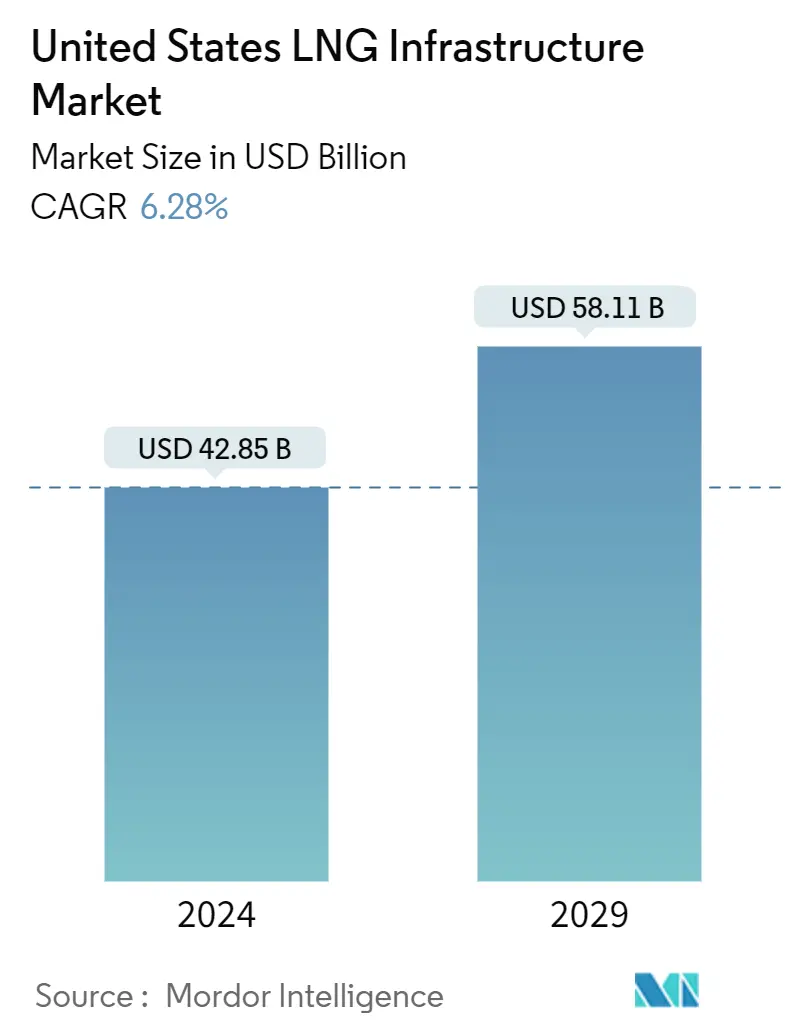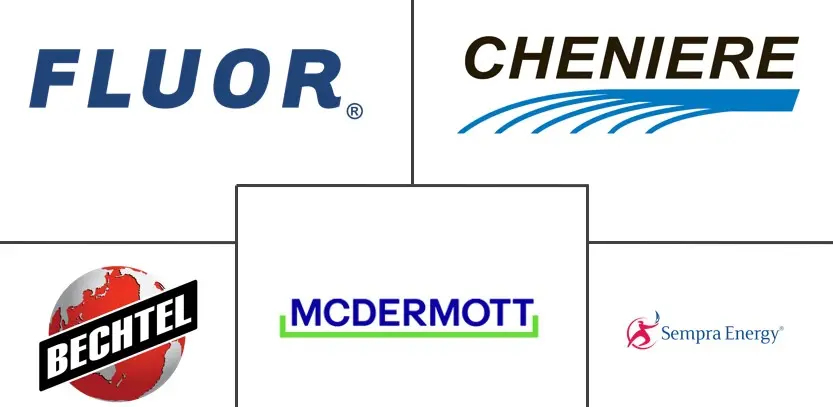Market Size of United States LNG Infrastructure Industry

| Study Period | 2019 - 2029 |
| Base Year For Estimation | 2023 |
| Market Size (2024) | USD 42.85 Billion |
| Market Size (2029) | USD 58.11 Billion |
| CAGR (2024 - 2029) | 6.28 % |
| Market Concentration | Low |
Major Players
*Disclaimer: Major Players sorted in no particular order |
United States LNG Infrastructure Market Analysis
The United States LNG Infrastructure Market size is estimated at USD 42.85 billion in 2024, and is expected to reach USD 58.11 billion by 2029, growing at a CAGR of 6.28% during the forecast period (2024-2029).
- Over the medium term, factors such as the growing uses of natural gas in various sectors, such as power generation, to have lower carbon emissions for a cleaner environment are expected to drive the market during the forecast period. Moreover, the United States became a net LNG exporter in 2017, owing to an abundance of shale gas, which led to increased investments in export facilities, in turn promulgating the demand for LNG infrastructure in the country.
- On the other hand, volatile natural gas prices led to decreased exports, and a glut of LNG is expected to hinder market growth.
- Nevertheless, as per the Energy Information Administration (EIA), non-OECD Asian countries like China, India, Bangladesh, Thailand, and Vietnam are expected to consume 120 billion cubic feet per day (bcf/d) of natural gas by 2050, outpacing regional natural gas production by 50 bcf/d. Hence, the United States is expected to be a major exporter of natural gas to these countries, creating major opportunities for the market players.
United States LNG Infrastructure Industry Segmentation
LNG infrastructure refers to the physical facilities and systems required to produce, transport, store, and distribute liquefied natural gas (LNG) from its source to end-users. LNG is natural gas that has been cooled to a temperature of -162°C (-260°F) to convert it into a liquid state, which makes it easier and more efficient to transport and store.
The United States LNG infrastructure is segmented into types. By type, the market is segmented into liquefaction plants and regasification plants. For each segment, market sizing and forecasts have been done based on revenue (USD).
| Type | |
| Liquefaction Plants | |
| Regasification Plants |
United States LNG Infrastructure Market Size Summary
The United States LNG infrastructure market is poised for significant growth, driven by the increasing demand for natural gas across various sectors, particularly in power generation for reduced carbon emissions. The U.S. has established itself as a net LNG exporter since 2017, leveraging its abundant shale gas resources to boost investments in export facilities. This strategic positioning has led to a surge in LNG infrastructure development, with the U.S. becoming a major player in the global LNG market. Despite challenges such as volatile natural gas prices and potential oversupply, the U.S. is expected to capitalize on growing demand from non-OECD Asian countries, which are projected to significantly increase their natural gas consumption in the coming decades.
The United States has emerged as a leading force in global LNG trade, accounting for a substantial portion of new liquefaction capacity and ranking as the third-largest LNG seller worldwide. The country's infrastructure, including major terminals like Sabine Pass and Freeport, underscores its dominance in the sector. The ongoing expansion of liquefaction facilities, such as the NFE Fast LNG 2 project, highlights the U.S.'s commitment to enhancing its export capabilities. With a fragmented market landscape featuring key players like Chiyoda Corporation, Bechtel Corporation, and Cheniere Energy Inc., the U.S. LNG infrastructure market is set to maintain its growth trajectory, supported by abundant shale gas supplies and strategic international trade relationships.
United States LNG Infrastructure Market Size - Table of Contents
-
1. MARKET OVERVIEW
-
1.1 Introduction
-
1.2 Market Size and Demand Forecast in USD billion, till 2029
-
1.3 List of Existing, Under Construction, and FID Liquefaction Facilities
-
1.4 List of LNG Receiving Terminals
-
1.5 LNG Import and Export Capacity, in BCM, till 2023
-
1.6 Recent Trends and Developments
-
1.7 Government Policies and Regulations
-
1.8 Market Dynamics
-
1.8.1 Drivers
-
1.8.1.1 Growing Uses of Natural Gas in Various Sectors
-
-
1.8.2 Restraints
-
1.8.2.1 Volatile Natural Gas Prices
-
-
-
1.9 Supply Chain Analysis
-
1.10 PESTLE Analysis
-
-
2. MARKET SEGMENTATION
-
2.1 Type
-
2.1.1 Liquefaction Plants
-
2.1.2 Regasification Plants
-
-
United States LNG Infrastructure Market Size FAQs
How big is the United States LNG Infrastructure Market?
The United States LNG Infrastructure Market size is expected to reach USD 42.85 billion in 2024 and grow at a CAGR of 6.28% to reach USD 58.11 billion by 2029.
What is the current United States LNG Infrastructure Market size?
In 2024, the United States LNG Infrastructure Market size is expected to reach USD 42.85 billion.

